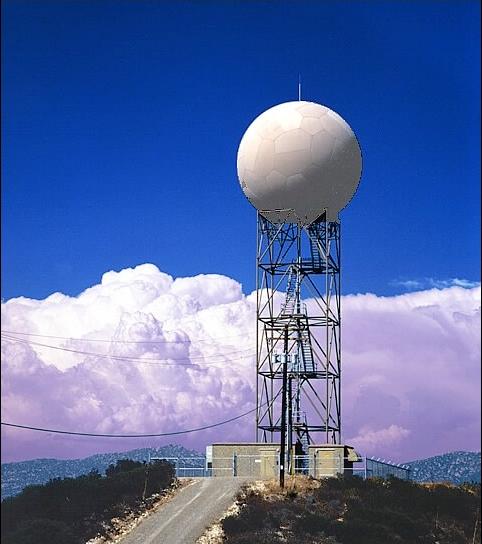What is weather radar and how does it work
Arab Weather - We all depend in our lives on the weather to plan our outdoor activities, and one of the most important tools that help us to determine and predict the weather is the weather radar, so what is the weather radar? How does it work?
Definition of weather radar
The name of the radar ( RADAR ) is derived from ( Radio Detection And Ranging ), meaning that the work of the radar depends on the use of radio waves, so that the radars send a beam of energy in the form of short pulses of radio waves (electromagnetic waves), which are intercepted by some objects in their path, and are reflected It's back to the radar.
The concept of weather radar is similar to hearing echoes, when a person screams in a well, for example, the sound waves are reflected from the water and returned for the person to hear, and in the same way the pulses sent by the weather radar are reflected from the raindrops, so that the signal returns to the radar, and appears on the radar screens in the form of information that includes the location of the clouds Rainfall and its intensity, and the type of precipitation that it carries (rain, snow, hail, etc.), as well as weather radars give information on how precipitation and rain clouds travel from one place to another.
Weather radar beginning and development
The beginning of the weather radar was an amazing coincidence, in the late nineteenth century, specifically with the beginning of the Second World War, when the radar was used to detect enemy ships and aircraft, and during that the radar operators noticed that they caused false signals to appear on their screens, working to jam potential enemy targets, Then they realized the new possibilities that could be detected by radar, and soon after the radars remaining after the war were used as rain detectors.
Since that time, modern weather radar has developed and improved greatly, as better methods have been integrated to obtain data with higher accuracy, and now most modern weather radars are pulse-Doppler radars , and these radars are able to detect the movement of raindrops in addition to the intensity Precipitation, and today specialized software uses radar data to make short-range forecasts, and is integrated into numerical weather prediction models to improve forecast accuracy.
How does modern weather radar work?
The modern Doppler radar system consists of a large radar dish protected inside a hex dome, so that the radar dish can rotate a full rotation (360 degrees) in the horizontal position, and about 20 degrees in the vertical position, and when the radar antenna rotates, it emits short bursts of radio waves called pulses (pulses), and are waiting for the return of these pulses to pick them up the radar dish, this process occurs very quickly where the duration of each pulse from the time of the transmitter to the back about 0.00099843 of a second.
Radio waves transmitted through the atmosphere move at the speed of light, and as soon as they collide with a target like a raindrop or a snowflake, the radio waves scatter in all directions and reflect some of them to the radar with different energy to indicate specific information, so the greater the size and density of raindrops, the greater the amount of energy that returns to Radar. The radar monitors all this information by repeating this process up to 1,300 times per second.
By monitoring the time spent by radio waves from transmission to their return to the antenna, the radar can calculate the distance and direction of the target using the Doppler Effect . In addition, the energy of the waves received by the radar provides information about the target characteristics, including size and intensity. The latest bi - polarization radars (dual-polarized radar) can also determine the type of precipitation.

What is the Doppler effect?
The Doppler effect is attributed to the Austrian physicist Christian Doppler, and this theory includes that the layer of sound in sound waves changes when there is a shift in frequency, and an example of this is ambulance sirens, which have a high volume as they approach, but the volume changes to become low When moving away, and by using this effect, the speed at which the ambulance is moving can be calculated based on the shift in frequency of the siren sound.
Weather Doppler radar uses this theory to determine the speed of movement of rain clouds in the atmosphere and the direction of movement in relation to the radar, and since rain clouds generally move with the wind, the wind speed can also be determined using Doppler technology.

Weather radars are bipolar
Dual polarization weather radar is a more advanced radar, while conventional radars send and receive pulses in the horizontal direction, dual polarized radars send and receive waves in the horizontal and vertical direction, and this gives a more detailed picture of targets in the atmosphere, allowing weather forecasters to differentiate between rain and snow And hail.

Arabia Weather App
Download the app to receive weather notifications and more..



